Rental News
Rental News Schlagzeilen
Ayrton Rivale lights up Red Rocks Amphitheatre for three nights of Brandi Carlile in concert
09/10/2025
Broadway musical “Maybe Happy Ending” uses Ayrton Diablo S fixtures in workhorse lighting role
06/10/2025
Robe celebrates at Sziget 2025
03/10/2025
Jeff Maker lights I Prevail with Chauvet
02/10/2025
Knw. by Live Matters unterstützt Jalsa Salana Deutschland bei smarter Veranstaltungssteuerung
28/08/2025
Romanian TV talent show “The Ticket” lit with Robe
The launch season of new Romanian TV talent show “The Ticket” premiered in September 2025 and is being recorded at Castel Studios just outside Bucharest. It is produced by Imagic and Antena 1 and lit by lighting designer/DoP Dan Andrei and lighting director Marius Matyas, using a large Robe moving light rig, which is owned by the Antena TV Group.
The show’s acts can vary greatly from a children’s choir group or a pop band, to a group of scientists finding the most efficient way to create a waving toilet roll effect using wind machines. On the rig are 24 Spiider wash beams, 18 T1 Profiles, 11 BMFL Blades, 12 LEDBeam 150s, 22 LEDWash 600s, 18 LEDWash 800s, and 48 Pointes, plus two rows of 16 MegaPointes at the back, among other fixtures.
A slick spherical stage set has been created by Peter Talea, including stylish bamboo frames and a large, curved LED screen at the back, with the live audience seated in front also in a round configuration, and this provided the starting point for the lighting design.
Andrei started with the initial creative concept and Matyas then fine-tuned this in WYSIWYG. They both developed the look from there and started pre-programming the basic building blocks. “We work with Robe products a lot as Antena 1 has them in stock”, says Matyas, who is now a freelance lighting designer/director, but had previously worked full-time for the broadcaster for 24 years. In the last two years, Antena 1 has steadily increased its Robe stock, which was delivered by Romanian distributor Senia Music.
Spiiders, LEDWash 600s and LEDWash 800s were positioned in the overhead rig for general stage washing and applying colour to the set. The BMFL Blades were used for back lighting, punching through in front of the LED screen with additional power and effects when needed, supported by the Pointes rigged on ladders at the back. The T1 Profiles were used for front and key lighting.
The other lights are around a central circular overhead truss, semicircular trusses upstage and two horizontal trusses at the front shaped with mirrored curves following the front and back contours of the stage. Andrei describes the style of lighting as “mainly bright, bold, colourful, and a bit quirky”, but the key was being able to switch from that to being dramatic, moody, and theatrical when needed.
Matyas has been working regularly with Robe products for around four years. Before Antena 1 bought their own, they would regularly rent them in as needed. While they don’t have any on this show, he lists T2s and Fortes as among his favourite Robe fixtures, in addition to the T1s and BMFL Blades.
The weekly episodes of “The Ticket” are filmed over three days and broadcast on the Saturday. The shoot days are long overall, but the amount of real time that Andrei and Matyas get to decide the lighting treatment for each contestant is only around twenty minutes. They use the same lighting rig for each episode, but there is some resetting in between.
Chief LX for the series is Alexander “Axl” Sora, and the stage manager is Eddie “Edi” Balteanu. “The Ticket” is being directed by Zoran Caramazan. Mona Segall is the general producer, and Robert Lionte is the executive producer.
(Photos: Antena 1/Gabriela Arsenie/Louise Stickland)
Ayrton Rivale lights up Red Rocks Amphitheatre for three nights of Brandi Carlile in concert
Singer-songwriter Brandi Carlile returned to Morrison, Colorado’s Red Rocks Amphitheatre for three back-to-back concerts on September 5-7, 2025. André Petrus acted as lighting designer and programmer for the shows, which featured 88 Ayrton Rivale provided by Brown Note Productions in Thornton, Colorado.
Petrus, a lighting and production designer who heads Nashville-based Outrage Media Group, has been using Ayrton fixtures for at least a decade but had not previously deployed Rivale. “I actually asked for a different fixture, but Brown Note recommended Rivale”, he shares.
Although Petrus did not have a history with Carlile he had worked with Sandbox Management, which teamed with Carlile’s Phantom Management on the event. His concept for the concert lighting was to use the venue’s unique rocky landscape as a set piece with no screens upstage and lighting illuminating the artist and the scenery.
“I was surprised to hear the Red Rocks team tell me that nobody ever really utilizes the scenery there”, Petrus recalls. “A Red Rocks date is usually a stop on a tour, so the performance is not built around the venue and there’s usually something upstage blocking the scenery. We got compliments about how they’d never seen the rocks lit the way we did.”
The 88 Rivale were the rig’s main moving lights and were positioned “everywhere”, according to Petrus. “They were shin lights, they were upstage in a ground row to give depth, they acted as the main key and back lights”, he explains. “Rivale were also mounted on three layers of truss running upstage to downstage to give yet another layer of depth and texture.”
PBS was shooting a special about the concerts so TV lighting was also a factor for the shows. “I generally light everything I do to be suitable for television since I come from that background and want everything to photograph really well”, Petrus notes. Brown Note also supplied Petrus with active and backup full-size GrandMA3 consoles with three medium PUs. “I’ve used GrandMA for most of my professional career and have my own GrandMA3 for programming in my studio”, he concludes.
(Photos: Phill McDonald/J Siegel)
Martin Heining und ETC setzen In-Extremo-Jubiläumsfestival auf der Loreley in Szene
Vom 4. bis 6. September 2025 hat die Mittelalter-Rockband In Extremo ihr 30-jähriges Bestehen mit einem Festival auf der Freilichtbühne Loreley gefeiert. Mit dabei waren Genre-Kollegen wie Feuerschwanz, Eisbrecher, Fiddler’s Green und rund fünfzehn weitere Acts. Für das Lichtdesign bei dem dreitägigen Event sorgte Martin Heining.
So schön die Open-Air-Location sein mag - für Lichtdesigner stellt die nahe des berühmten Loreley-Felsens gelegene Bühne eine Herausforderung dar. Aus zwei Gründen, wie Heining erklärt: „Zum einen wäre da die Bühne. Sie hat eine geringe Clearance, ist sehr breit und hat nur wenig Dachlast. Zum anderen steigt die Zuschauerfläche sehr steil an, der FOH war zum Beispiel über der Bühne. Das alles zusammengenommen macht es einem nicht gerade leicht.“
Eine weitere Hürde basierte auf dem Konzept des Geburtstags-Festivals: „In Extremo haben an den drei Tagen jeweils ein unterschiedliches Set gespielt“, fährt Heining fort. „Das heißt: Ich hatte es mit einer enormen Anzahl von Songs zu tun - und für jeden einzelnen Track musste ich das jeweils passende Licht kreieren.“
Der renommierte und schon lange für In Extremo tätige Lichtdesigner nutzt seit vielen Jahren Hog-Konsolen von ETC, so auch beim diesjährigen Jubiläumsfestival. Neben einer Hog 4 (Backup mit Hog-Version-5.0-Software) fungierte hier die neue Stage Hog als Dreh- und Angelpunkt der Lichtinszenierung. Eine 19 Zoll große, im 2-HE-Rackformat gestaltete und 64 Universen bietende HPU (Hybrid Prozessor Unit) rundete als DMX-Prozessor Heinings Konsolen-Equipment bei dem Event ab.
Aus dem Scheinwerfer-Segment setzte Heining unter anderem einen brandneuen ETC-Scheinwerfer ein: Das Gerät soll erst demnächst offiziell veröffentlicht werden, Heining durfte während des In-Extremo-Festivals jedoch schon einen Beta-Test durchführen. Sein Urteil: „Ein extrem heller Scheinwerfer mit einem enormen kreativen Potential.“
(Fotos: ETC/Jan Heesch)
Organissimo and Elation deliver lighting at Americana Trade Fair 2025
The Americana Trade Fair in Friedrichshafen, Germany, is Europe’s largest trade fair for Western riding and equestrian sports. At the heart of the event is the Show Arena, a 36 m x 72 m space hosting horse shows, competitions, demonstrations, and broadcasts to both live and online audiences.
For the 2025 edition, held from September 3 to 7, Organissimo - official service partner of Messe Friedrichshafen - worked with Elation to illuminate the arena. Activities began as early as six in the morning and ran until midnight, with rehearsals often stretching into the early hours. This meant the lighting system had to perform under near-constant use. The arena was captured on eight to nine cameras for both broadcast and livestream.
The welfare of the horses was paramount. Traditional halogen fixtures had not only failed frequently, requiring constant bulb changes, but they also projected blinding light that could distract riders and animals. With fixtures mounted high on trusses above sensitive arena sand, there was no opportunity for quick maintenance if something went wrong.
The venue knew they wanted to upgrade to LED, and the solution was Elation’s KL Panel XL. Organissimo mounted seventy units across three long trusses running the length of the hall, along with additional trusses at each end to achieve full coverage. Organissimo’s Martin Knauer chose the KL Panels for the arena lighting and created the overall lighting design.
The KL lights were integrated into the overall production by Organissimo, which not only managed lighting, sound, and video but also oversaw some construction and provided behind-the-scenes support. Organissimo collaborated with camera teams, who specifically requested LED panel softlights, something that would not project blinding light but could cover the entire arena in a uniform wash.
The LED panels enhanced video capture without distracting riders or animals, while the RGBWLC engine provided the softer color tones requested by the client. The KL Panel XL units worked in conjunction with moving head fixtures, enabling Organissimo to combine uniform soft washes with dynamic spotlighting for specific scenes and performances.
For the first time, the Americana arena could transition seamlessly between crisp competition lighting and immersive colored scenes, something previously impossible with the halogen system.
(Photos: Organissimo)
Broadway musical “Maybe Happy Ending” uses Ayrton Diablo S fixtures in workhorse lighting role
Five-time Tony Award-nominated lighting designer Ben Stanton chose 58 Ayrton Diablo S fixtures for Broadway’s “Maybe Happy Ending”, the South Korean musical about human-like helper-bots who forge a relationship. “Maybe Happy Ending” premiered in Seoul in 2016 and has enjoyed many international runs before arriving at Broadway’s Belasco Theatre in September 2024. The production recently won six Tony Awards, including one for “Best Musical” with Stanton receiving a nomination for his lighting design.
Prior to “Maybe Happy Ending” Stanton had used various Ayrton fixtures for concert touring but had not deployed them on theatre projects. For this show he needed “a very small, powerful fixture that could be a workhorse for the design” and Diablo filled the bill. “I needed a light that would fit nicely on the balcony rails of the beautiful Belasco Theatre as well as fit into very small spaces overstage”, he says. “The house electrician Justin Freeman recommended I look at Diablos.”
PRG provided Stanton with 54 active Diablo S fixtures and four spares. Some are mounted on the balcony rail where they largely function as front lights. He uses the Diablo’s shutter assembly to shape the light to the apertures of the moving portals in the set design. Additional Diablos hang over the stage on 12-inch trusses where they serve as side lights and back lights. “We can also lower these fixtures in between tiles on the video ceiling to downlight certain places on stage”, remarks Stanton.
As for the lighting design, he furthers: “One of the hallmarks of the design is how we use colour. A lot of the musical takes place in small, white apartment-like boxes, and a big part of the storytelling in ‘Maybe Happy Ending’ is achieved through the use of saturate colours in these spaces. The colour mixing in this fixture allowed us to create many beautiful fields of colour. This combined with the shutters, gobos and optics made the Diablo the perfect light for this production.”
PRG also supplied the show with active and spare MDG ATMe haze generators and MDG Max 3000 APS fog generators. “I specify MDG atmospherics for every project that I can”, says Stanton. “The CO2-based haze is much smoother and finer than other types of atmosphere. The ATMe runs throughout the majority of the show with more intense SFX requiring the fogger appearing toward the end of the show.”
For the production Ken Elliott is the Associate Lighting Designer, Kat Morrill the Assistant Lighting Designer in charge of followspots, and Ron Schwier the Production Electrician.
(Photos: Matt Murphy)
Robe celebrates at Sziget 2025
At this year’s edition of the Sziget festival in Budapest, Hungary, Robe moving lights were prominent on several major stages, including: the Bolt Night Stage supplied by Light Positive with some fixtures that were a brand-new investment; The Revolut Stage supplied by VEG Europe, and the Main Stage, supplied by Colossal.
Robe’s distributor AVL Trade organised an exclusive word-of-mouth backstage area and tech hub for all crew, creatives and others working BTS across the site, which included the Avostream mobile demo vehicle, a comprehensive merch cabin, a bar and chilling zone under the trees, complete with loos adjacent to the Night Stage backstage village, which brought the buzz of artists coming and going. Up to 60,000 festival fans attended each day.
“It was another great event for us in terms of networking, reconnecting with our industry friends and acquaintances and making new contacts, including visiting lighting directors and operators”, says AVL Trade’s Csaba Csanádi. “It was excellent to see so many Robe products in use festival-wide.”
Bolt Night Stage, previously known as the Party Arena, is a 10,000-capacity tent and Sziget’s core for electronic music fans and revellers keen to rip up the 10 p.m. to 5 a.m. hours, with a lineup featuring Armin van Buuren, Steve Angello, Amelie Lens, Boris Brejcha and many more.
The Night Stage lighting design was created by Netherlands-based visual design specialist The Art of Light, led by Andre Beekmans. The company also provided the production lighting design for the Colosseum Stage. Overseeing The Art of Light’s work on site was Kasper Dijksterhuis, who created the plot, drawings and renders with Beekmans.
A major feature of Twofiftyk’s environmental design for this space was fourteen automated “visual” pods rigged with lighting and video elements, hung in the roof above the audience, which enabled the architecture of the space to be changed each day - and during each artist as required.
Additional trusses ran the length and width of the ceiling area available for lighting, audio and video positions, and the onstage widescreen LED behind the DJ booth accentuated the epic yet fun feel of the space.
Each of the moving pods contained ten Robe LEDBeam 350s, with additional LEDBeam 350s also used as side key light for the DJ. Twenty Robe Fortes were positioned along the top of the upstage screen and on the trusses left and right of this, placed for back lighting. In the roof trusses, sixty MegaPointes were positioned to beam down, along and around the audience area.
The Night Tent was hosted by a series of different curators each night, some of whom supplied their own lighting directors/head of lighting for their evening, e.g. Robbert-Jan Vernooij who oversaw and ran lighting for the Awakenings line up on the Friday night.
The Fortes and 24 of the total 142 LEDBeam 350s were new purchases by Hungarian rental company Light Positive, which has been supplying this stage at Sziget for the last six years. They also purchased more MegaPointes at the same time, and have around 250 Robe products now in the current rental fleet.
A Light Positive team of six including Nandor Ládos and Sándor Orosz looked after the Night Stage, but their total crew on site was around sixty as they also supplied three other areas, including The Circus Stage and the Street Theatre Stage. Both of these featured Robe Tarrantula wash beams, which were also part of the new batch of lights delivered to them by AVL Trade.
The Revolut Stage, the second biggest of the event, featured a mix of global stars, local gems, and rising talent, including Justice, Empire of the Sun, Blossoms, Caribou, Papa Roach and loads more. Looking after lighting here were Bence Doma and Almos Bus, both regular freelancers for VEG (Visual Europe Group).
The overhead house lighting rig comprised 24 Fortes, 22 Tarrantulas, 34 MegaPointes and twelve Tetra2s, as well as a variety of different floor packages, some with additional Robe fixtures, which they also supplied to certain acts. The house lighting rig was designed to cater for up to six bands a day. The house lighting was rigged on an 8-leg steel ground support system.
Production lighting for Sziget’s Main Stage was designed by Mark Kontra, part of the team from rental specialist Colossal, which supplied all the lighting kit for this area. Kontra has been involved in some capacity with this stage and the festival for the last fourteen years, and since 2015 has headed up the Main Stage lighting team.
The Robe count this year was over 300. This included 56 Fortes, thirty iForte LTXs, six FS (follow spot) versions and 24 standard, forty iFortes, 56 Pointes, 38 ColorStrobes, 34 iBar 15s and 48 LEDBeam 350s, with four RoboSpot systems available for those wanting to make use of the iForte LTX FSs which were installed on the four FOH towers.
Main Stage headliners this year were Charli XCX, Chappell Roan, Shawn Mendes, Kid Cudi, Anyma and Post Malone. Robe’s own live musical talent also made a surprise appearance on the Johnnie Walker Stage with a special collaboration between DJ Stereonoize - Csaba Csanádi from AVL Trade - and Robe’s international business development manager Bram de Clerck - DJ Phos - who played a funky set that energised an otherwise relaxed Thursday afternoon in the heat.
(Photos: Louise Stickland/Paul Clarke)
Jeff Maker lights I Prevail with Chauvet
To set the tone for American metal/post-hardcore band I Prevail’s “Summer of Loud” tour, Las Vegas-based lighting designer Jeff Maker used twelve pyro effects positioned upstage, mid-stage, and downstage. Throughout the shows, the fiery effects underscored the core character of the band’s performance.
Nevertheless, Maker was careful to arrange the pyro units so they did not block the lighting. Altering the light angles throughout the show, he gave each song its own emotional flavor, while his strobing, audience lighting, and pyro effects kept the adrenaline pumping. “Light angles played a big role in setting moods and moments throughout this design”, says Maker. “By shifting between uplighting, side lighting, and crowd lighting, I could sculpt the band differently from song to song. I felt that it gave the show a dynamic flow and kept the visual storytelling evolving.”
Color also helped shade the mood on stage. “As a designer it’s my job to magnify the meaning of songs and capture the emotion of what the artist is trying to convey”, notes Maker. “I try to approach every song with an open mind and interpret each one in my own way as well, blending it all together in harmonious colors that work in holy matrimony with the video content.”
Helping Maker pull this tapestry of moods and feelings together were thirteen Chauvet Professional Color Strike M motorized strobe-washes, which, like the rest of his rig, were supplied by BBM Clair. The fixtures were positioned inside three rows of metal wire risers, which themselves gave the stage an edgy industrial look.
“We had grated risers located on the downstage edge, mid-stage, and upstage, and had our Color Strike M units inside them”, says Maker. “This allowed us to punch up through the stage and reach out toward the crowd with some vivid white strobe effects. At other times, we directed them back toward the set with some cool washes.” Changing the direction and nature of the light from the Color Strike M fixtures created constant visual evolution on stage, he adds.
(Photos: Jessika Wollstein)
IPS calls on over 530 Chauvet fixtures for “Mission: Impossible” premiere
Multi-Grammy winner Rod Stewart wasn’t the only non-film-star celebrity to turn out for the world premiere of “Mission: Impossible - The Final Reckoning” at London’s Leicester Square - stars like Dua Lipa, Idris Elba and Florence Pugh were also there, even though they were not involved in the film.
A production executed by Limited Edition Event Design (LEED) helped the glamour sparkle during the event. For technical support and lighting, LEED turned to its frequent collaborator, Milton Keynes-based IPS. To ensure that the premiere was shown in the best light for the sizable live crowd, as well as for millions of fans who watched the broadcast and other media coverage of the event, IPS used 530-plus Chauvet Professional fixtures and panels that were positioned throughout the site.
Included in this collection were over 460 REM 3IP LED video panels. Displaying images from the film and its stars, the panels were positioned across a 50-meter main platform, as well as on branding walls around a custom-built fountain and entrance arch, all with 3D design and full safety sign off.
A collection of forty Color Strike M motorized strobe-washes pumped up the energy level. Given the large number of celebrities on hand for the event, the media-interview area was a busy place. To ensure that all camera shots came off smoothly, IPS installed thirty OnAir IP panels.
(Photos: Chauvet Professional)
Robe supports Hungarian National Day spectacular
Hungary celebrated its National Day on August 20, 2025, with a 35-minute timecoded show in Budapest, involving monumental projection, lasers, lighting, drone shows and a massive firework display which blew up along a 5 km stretch of the Danube River.
Visual Europe Group (VEG) was the event’s main technical supplier, providing sound, lighting, lasers, video walls, projection mapping, and a large-scale drone show for this extensive main city centre site along both sides - Buda and Pest - of the river. Robe moving lights - iBolts, iFortes and iForte LTXs - played a significant role in illuminating four key architectural elements - the 118-metre-wide Hungarian Parliament Building, the Hungarian National Gallery, the Széchenyi Chain Bridge and Elisabeth Bridge.
The project was managed by VEG’s in-house team, with all key technical decisions handled internally. Project lead Zoltán Ösz oversaw end-to-end production and delivery in alignment with the creative design team at Gyár Post Production Company, sister company and part of the Visual Europe Group.
Tibor Kalla was the lighting designer. It was the first time he had worked in this capacity on the National Day event, although previously he had been part of the team as a systems engineer and network installation specialist. He collaborated closely with VEG to choose the best fixture placements around the city to create the desired overall lighting aesthetic.
Eight Robe iBolts were positioned on top of the Chain Bridge’s two arches. iBolts were used as beacons of light to draw attention to the bridge as a focal point of the show. During the timecoded show, the arches were illuminated with projection, and the iBolt’s sky beams were synced with the music and projections. At the Parliament building - on the Pest side of the river - ten iFortes were positioned to illuminate the North side of the building, supporting the projections that appeared on its front facade.
The Hungarian National Gallery sits on the Buda bank of the river and is part of the Buda Palace complex. One of the highest altitude points across the whole city, it is highly visible as part of the show vista, and this year its front facade and central dome were illuminated with sixteen iForte LTXs in a series of different colours plus gobo texturing to give it more depth and resonance. The iForte LTXs were sitting on scaffolding towers built and spaced out along the Savoy Terrace in front of the National Gallery.
The Elisabeth Bridge pylons were illuminated with a total of sixteen iForte LTXs, with another 64 iFortes shooting beams off the sides. This bridge, built at the narrowest part of the Danube spanning 290 metres, was the furthest southern point of the main show site, with the Margaret Bridge being the most northern point in the opposite direction along the river. The fixtures were placed on staging platforms spaced along the bridge’s pedestrian walkway sections.
The Robe products were part of around 900 lighting fixtures deployed around the city centre site by VEG for a show that attracted approximately 1.5 million visitors to the city for a day of celebration, which saw Budapest become a big carnival with a distinctive festival atmosphere. Among the major challenges for the VEG team of 250 was coordinating with all the other independent technical departments, so when they arrived on-site, both the power supply and data infrastructure were already in place across this vast urban landscape.
The projection mapping was achieved using 67 Panasonic PT-RQ35K 35,000-lumen projectors and Disguise VX4 media servers, set up in containers at the main control position on the Buda side of the river opposite the Parliament building. They were shooting around 400 metres across to the facade of the 1902 neogothic architectural masterpiece.
The lighting build started on August 13 and continued until the evening of August 18, with just one rehearsal on August 19. Lighting rigging on Elisabeth Bridge was left until last, as it was only accessible once all the city centre road traffic closures were in place, coordinated by the police department. The fireworks were designed and executed independently by Budapest-based pyro specialists Nuvu and were fired from multiple sites, including a series of barges moored along the river.
The complete overall event organisation was delivered by Lounge Event, an event management agency sharing the same ownership as Visual Europe Group.
(Photos: Louise Stickland)
Elysée-Palast ordert ETC-Lonestar-Scheinwerfer für Auftritte Emmanuel Macrons
Die für Auftritte des französischen Präsidenten Emmanuel Macron zuständige Abteilung hat kürzlich Licht-Systeme von ETC geordert: Sechs High-End-Systems-Lonestar-Scheinwerfer wurden an den Elysée-Palast geliefert. Sie bilden das Herzstück zweier mobiler Beleuchtungs-Sets.
Um zwischen den vielfältigen nationalen und internationalen mobilen Anwendungen keine Engpässe zu riskieren, stellte das präsidiale Lichtteam zwei identische, aus jeweils drei Lonestar-Scheinwerfern bestehende Licht-Sets zusammen.
(Fotos: Soazig de La Moissonnière/Alexandra Lebon/Durand Thibault/Présidence de la République)
Paul Guthrie embraces classic look with Elation’s Fuze Wash 500 Fresnel
Soft field light has long been delivered through classic Fresnel fixtures, but with the industry’s shift to LED technology, designers have sometimes found themselves missing the vintage look that Fresnels brought to the stage. When it comes to achieving that more poignant feel, lighting designer Paul “Arlo” Guthrie often turns to Elation’s Fuze Wash 500.
“I love that the Fuze Wash 500 has a Fresnel lens, which is a look I’ve really missed since the shift to LED wash fixtures”, Guthrie shares. “I love having a homogenized soft light look right at the source which feels mildly nostalgic.” In 2025, he used the Fuze series fixture on three high-profile productions: Finneas’ “For Cryin’ Out Loud!” tour (February-July 2025), Kelly Clarkson’s Studio Sessions Residency (June 2025 through 2026), and Nine Inch Nails’ “Peel It Back” tour (May-October 2025).
The designer says the fixtures provided similar aesthetics for the three projects although their application and placement varied. For Finneas, supplied by Volt (North America) and Neg Earth (Europe), he mounted the fixtures on floor stands with barn doors to emulate film and TV-style side and backlight. “We wrote sequences that incorporated the barn doors’ movement - opened or rotated - to add a different dynamic to the songs, as well as a physical element on stage”, he explains.
On Kelly Clarkson, 28 Fuze Wash 500s supplied by Majestic Productions were built into an overhead slotted ceiling set piece to look like can or downlights. “They provided a soft base for the stage but doubled as beam fixtures in some songs”, says Guthrie.
For Nine Inch Nails, the designer deployed 54 Fuze Wash 500s, supplied by Upstaging (North America) and Neg Earth (Europe), built into carts that make an upstage element for a wall of light reveal. The lights serve multiple roles - from architectural illumination to emulating par cans and tungsten fixtures, and, as Guthrie puts it, to “just plain old destroy everyone’s face in some songs”.
(Photos: Elation/Andi Elloway Studio LLC)
Jonathan Rikner chooses Chauvet for Hov1’s “Farewell Show” in Stockholm
To illuminate Swedish hip-hop group Hov1’s “Farewell Show” at Gärdet Stockholm, lighting designer Jonathan Rikner (of Ncoab Productions) opted for Chauvet Professional’s Colorado PXL Bar 16. “The original idea for this show was to be able to build ‘rooms of light’ with emotions”, he says. “I chose the PXL bar for this reason - it has a nice uniform light output, which can confine a space.”
“That was in the concept phase”, he continues. “Later, when I had the rig out for the first time, I played around with different looks and expressions. That’s when I saw that it makes a really nice effect to alternate between horizontal and vertical bars.” After experimenting with this design concept on different Hov1 shows, Rikner rolled out a full-fledged version of his vision for Hov1’s “Farewell Show”. The record-setting crowd of 52,236 (the previous record was held by Metallica) at the outdoor venue was taken on a visual journey, as the stage metamorphized through a series of radically different looks.
At times, the stage was mostly black with shafts of bright light running from its deck to the top of its trim. At other times, it took on sweeping horizontal looks dominated by a video wall accented by bright light, before it was transformed again by pyro effects and haze. “Smoke/haze is really important, especially with a fixture such as the PXL Bar”, notes Rikner. “This makes the show seem like more than only a post stamp on stage - it actually reaches out over and into the audience.”
Rikner used 178 PXL 16 Bars, supplied by Creative Technology Sweden, in his deeply layered 178-universe show that had 44,000 parameters. He outlined the entire stage and catwalk with the pixel-mappable RGBW motorized battens, in to having an upstage frame around the entire video wall, a mid-stage LX with vertical framing sides, and two vertical LX downstage near the PA. “I ran the PXL fixtures in 186-channel mode to be able to make smooth fades and transitions through the entire rig”, explains Rikner. “To be able to make a constant fade for more than thirty seconds is great. The PXLs were the main fixture type for the show - they acted as a wash, beam, and effect fixture.”
Looking back on his show, Rikner says it was the element of surprise that made it extra special. “It was nice having the horizontal bars in unison giving the song its absence energy, and then using the vertical bars for something completely different”, he explains. “It’s easy to get stuck in thinking only a strobe can be a strobe, or only a wash can be a wash. But to surprise and make a punch with all the vertical bars as strobe for example really switches things up.”
“My rig made this show work as did my wonderful crew: Fredrik Jönsson doing key lighting, Edvard Hansson doing the Follow-Me system, Bombee doing SFX - and of course a thanks to our FOH sound guys Johan and Søren along with the entire crew”, Rikner concludes.
(Photos: Chauvet Professional/Robin de Blanche)
John&Jane and Chauvet support Hype’O Dream festival
Change was the order of the day at the 2025 edition of Hype’O Dream. In addition to moving its schedule up a month earlier, the dance festival in Waregem, Belgium, had live band performances on stage for the first time in its 11-year history. The festival featured a kinetic lighting and production design from John&Jane - Premium Technical Event Support, using 266 Chauvet Professional fixtures.
Hype’O Dream’s main stage, which rose in steps until it reached its towering center apex, created a cathedral-like setting that lent itself to an electronic dance celebration. At the heart of the stage were forty Maverick Storm 1 Flex fixtures. A collection of 95 Strike P38 blinders, 63 Rogue Outcast 1 BeamWashes, and four Strike Array 4 units also drew festival goers into the dance music with bright beams of light.
On the stage itself colourful light from 48 Colorado Panel Q40 RGBW rectangular washes reflected the mood of the music with a flow of changing palettes. Through their varying light angles and colour mixing, the Colorado fixtures also contributed to the backdrops on the stage.
Lending an added visual dimension to the stage were the rig’s sixteen Color Strike M motorized strobe-washes. The fixture filled a wide range of roles during the two-day festival, providing background light and stage washes, as well as being used for pixel-mapped effects.
(Photos: Jürgen de Witte/WIT Fotografie & Videografie/Say Hey)
High Lite Touring supplies Robe MegaPointes to “Beats for Love”
Czech rental company High Lite Touring supplied fifty Robe MegaPointe moving lights for the main Love Stage at the 2025 “Beats for Love” festival, currently the largest electronic dance music festival in central Europe, staged annually at Ostrava in the Czech Republic at the former Dolni Vitkovice steelworks.
The Love Stage design was a collaboration between the festival’s creative team and High Lite Touring, with a lighting design by Václav Olsar from High Lite Touring. Multiple LED screens were integrated into the visual environment, providing a spectacular centrepiece for the event.
When it came to lighting, there was some input from visiting artists, but Olsar was largely left to imagine the lighting scheme himself. A major inspiration for the aesthetic was the theme of love and unity. The fifty MegaPointes were rigged around the set, positioned in between the various décor elements and standing out amidst around 450 other lights on the rig.
This year’s lineup included some of the greats of the genre, including Axwell - one third of the Swedish House Mafia - who was playing “Beats for Love” for the first time, Armin van Buuren, Timmy Trumpet, and Sub Focus, as well as Belgian duo Dimitri Vegas & Like Mike who also made their debut appearance at the festival.
The “Beats for Love” stage construction took nine days to complete and involved nearly 100 people, with the show running handled by 44 specialists from all technical disciplines - audio engineers, lighting designers, media server operators, laser operators, audio, video, and lighting technicians, stage managers, operators for special effects and pyrotechnics, and stage crew.
High Lite Touring, who are based in Ostrava, have been supplying lights to “Beats for Love” since 2016. The company has a lot of Robe in its inventory, mainly MegaPointes, BMFL WashBeams, and RoboSpot systems.
(Photos: Beats for Love/Tereza Czyz Photography/High Lite Touring/Jan Pulkrabek/Jakub Zatloukal)
Gil Perron calls on over 400 Chauvet fixtures to celebrate Montreal Pride
At this year’s edition, Fierté Montréal (Montreal Pride Festival), one of the largest pride fests in the world, gathered 750,000 visitors from all over the world, over 10,000 participants in 120 events, and 428 Chauvet Professional fixtures on the massive main stage and grounds.
The lighting and production design for the 11-day event in Montreal’s Olympic Village was created by Gil Perron and transformed the main stage and sprawling site in and around Olympic Village into a visual wonderland that surprised and delighted at every turn with its bold color combinations and lively scenic elements.
Working with a team including site LD Kevin Beland Laflamme, master electrician Penelope Tremblay (assisted by Christian Mercier and Ryan Germundson), Perron used his massive rig to conjure up a fast-moving stream of fresh and original images that spoke to the “express yourself” theme of the event. Casting aside the familiar prohibition about using too many colors at once, he and his team dipped into the wells of their collective imagination to ring the main arena and wash the stage with a rainbow of hues.
The explosion of colors didn’t result in muddy confusion either, Perron ensured that all parts of his broad palette stood out by separating them and using variously shaped set pieces to create demarcations. Larger scenic pieces weren’t merely lit at this festival; they were animated with distinctive colors that are rarely found in ordinary palettes. For example, a massive high heeled shoe outside the stadium glowed against the starry night sky in a unique shade of lilac purple.
Helping to bring this vision to life outside the stadium were 48 Colorado Q40 IP65-rated RGBW rectangular wash lights. Over at Pride Park, 196 Colorado Quad Par fixtures and 44 Ovation Reve E-3 IP full spectrum fixtures ensured that vibrant colors flowed everywhere. At the main stage, where shows were run by LD Fahed Hamammi, Perron flew his fixtures on a series of four semi-circular truss structures, measuring 60, 40, 32 and 24 feet in diameter. He arranged these structures in a horseshoe configuration in order to “offer and open arms visual and signify inclusion”.
The flown fixtures made it possible to create a wide variety of looks with lush washes, bold aerials, evocative light angles - and, of course, colors, colors and more colors. They included 64 Rogue Outcast BeamWash 1 units, 48 Maverick Force 1 Spots, sixteen Maverick Force 3 Profiles, eleven Maverick Storm 2 Profiles, fourteen Colorado PXL Bars, twelve Colorado Q40 washes and nineteen Colorado Quad Pars.
(Photos: Chauvet Professional/Yan Di Fabio/Fierté Montréal)
Elation and Apart power Untold Festival’s 10th anniversary main stage
Elation lighting fixtures took center stage at the 10th anniversary of the Untold Festival, one of Europe’s largest music festivals, held August 7-10, 2025, in Cluj-Napoca in the Transylvania region of Romania. With more than 470,000 attendees and a lineup featuring Post Malone, Armin van Buuren, Martin Garrix, Tiesto, Becky Hill and more, the milestone edition was celebrated with a production that blended folklore-inspired staging with lighting.
For the first time, Apart Productions, led by Andrei Predut, took charge of Untold’s main stage lighting after several years of working on the festival’s secondary stages. As part of the team, Florina Dascal served as the overall Art Director, Bobo Nedelcu from Apart Vision was the Head VJ and Video Designer, and Alex Mihut, Head of the Sound Department at Apart Sound, led the audio direction.
Predut and his team, working in partnership with gear provider Bivolu and Elation’s Romanian distributor Zeedo, turned to Elation’s SOL I Blinders, Proteus Hybrid, and Proteus Hybrid Max fixtures to bring the ornamented stage to life. The Untold main stage is a massive, multidisciplinary undertaking, with artistic direction, structural engineering, and technical design all working in unison. For the festival’s 10th anniversary, the stakes were higher than ever, with a strong emphasis placed on the stage’s unique decorative frame - a defining element that set the visual identity of this year’s celebration.
The main stage design, inspired by Romanian fairytales and folklore, featured an elaborate dragon motif that was dramatically brought to life using 130 SOL I Blinders deployed not as traditional blinders but as eye candy and texture enhancers to accentuate the dragon décor. Arranged in a crisscross design to mimic dragon scales, the SOL fixtures highlighted the ornate décor using gradients and dynamic color shifts that brought depth and motion to the scenery.
“We needed the dragon to come alive rather than just lay down a large brush of color, which would have been a bit boring”, says Predut, who supervised the main stage lighting team. “That’s why we used lots of smaller sources, so we could create gradients and patterns that followed the contours of the décor.” While guest LDs managed artist lighting, Apart maintained control of the décor frame to ensure the look reflected Untold’s signature visual identity. Forty-eight Proteus Hybrid fixtures formed a crown of beams that filled the stadium, creating what Predut describes as “a dome or coliseum of light” effect. Ten Proteus Hybrid Max fixtures, mounted in hard-to-access positions beneath the stage, delivered gobo textures.
While Elation’s presence in the Romanian rental market has been limited, Untold marked an important moment for the brand in the country. With Zeedo’s support, Apart Productions sourced additional units through Motion to meet the scale of the production. “The market is shifting, and local rental companies are discovering other brands like Elation”, says Predut. “For big outdoor festivals, I look at Elation fixtures.”
(Photos: Elation/Pixium.Photo)
Lightswitch create images on Halsey tour with Chauvet’s Color Strike M
Multi-Grammy winner Halsey’s recent “For My Last Trick” tour concluded on July 6, 2025. The artists was intimately involved in creating the look for the 30-city tour - a look that interwove the dramatic expectations of theatre with the raw energy of rock and a rainbow of colors.
“‘My Last Trick’ was definitely a more theatrical than a typical tour”, says John Featherstone, who worked with his Lightswitch colleagues, Hailey Featherstone and Ignacio “Iggy” Rosenberg on lighting the show. “Given that there were multiple acts, it was important for Halsey and her team that there was a strong differentiation between each stage of the show we were in.”
“There were moments of real softness and emotion; raw, vulnerable emotion”, he continues. “Then there were moments of the badass rock’n’roll chick; and then there were moments of her talking about all the health struggles she went through and how that changed her as a person; becoming a mother, and how that affects everything. It was a balancing act of those different, really important viewpoints, and about making it feel cohesive. That’s always the biggest thing, stitching it all together.”
The Lightswitch team collaborated with Halsey and her manager/creative director Anothony Li, as well as scenic designer Derek McLane, cinematographers Joe Ranson and Nathan Amzi, LD Malcom Harrison, and programmer Anna Merritt. “Since the show was divided into theatrical and rock sections, we all got to show our individual styles”, says Rosenberg. “It was also incredibly refreshing to have such close conversation with an artist.”
In its theatrical section, the show relied heavily on the art of the reveal. The rig’s 22 Chauvet Professional Color Strike M motorized strobe-washes (supplied by 3G Productions), which were positioned on the risers dotted around the band, and on the front truss, were instrumental in helping the designers achieve the desired effect.
“The band was mostly hidden behind a vanish wall during the first half of the show”, says Rosenberg. “We used the Strike Ms to start creeping them in as the act advanced. It let them pop through in moments so the audience could start to guess that there was ‘something else’ behind the LED wall. In the second act we used the Strike Ms as an uplight for the band, as well as another layer of audience lighting. We flipped them around to fill this dual role. We used them a lot more as whimsical accents on the theatrical first act. On the second act we kind of went all out, and they did a lot of ‘audience abuse’ so to speak.”
“They added punch and punctuation to the rig”, adds John Featherstone. “If the rig were a drum kit, the Strike Ms were our cymbals. Halsey also likes to really integrate her audience into the show - the twelve of these fixtures on the front truss brought the action and excitement out into the audience.” A big part of that excitement stemmed from the bold and vibrant monochromatic color scheme that often animated the stage. “I am by far a monochromatic designer”, declares Rosenberg. “We also had to think about our interplay with the set, video, and cameras, so helping keep the show homogeneous was a big part of that decision.”
Of course, the show also featured intriguing color combinations, such as the one that supported the song “Gasoline”, a moment that Featherstone and Rosenberg both cite as one of their favorites. “It had this amazing and counterintuitive mix of deep blood red, and a brittle gasoline green - truly remarkable”, says Featherstone. “It was definitely a moment where we wanted to get into the uncomfortable side of lighting”, adds Rosenberg. “The colors were all just a shade ‘off’, and when there were super bright moments it just barely broke white. It was also just at the cusp of being unbearably bright - and then it resolved. It’s always somewhat unsettling but it works. We also played with making these patterns on our rear wall that almost look like totems but they were so fast that most people only had a latent idea of them being there.”
As the designers point out, their client was deeply involved in the show’s transcendent color combinations. “Halsey has synesthesia, specifically chromesthesia, where she associates sounds with colors, so the stimulation of cognitive pathways for her leads to an involuntary experience in another”, explains Featherstone. “So, all this is very connected to her, not only the way that sound triggers color, but the way color triggers sound. It’s really quite fascinating.”
(Photos: Chauvet Professional)
Cadre Noir of Saumur illuminated with Chauvet
Highlighting the aesthetic harmony of horses and their riders at Cadre Noir of Saumur - a riding exhibition that took place at the seaside resort of Le Touquet-Paris-Plage, France - was a lighting design featuring sixteen Chauvet Professional Maverick Storm 2 Profile projectors supplied by Alive Angers, the technical provider for sound and lighting.
“We needed IP65 fixtures, given that the shows are held outdoors and there is a lot of dust with the Cadre Noir horses, not to mention the potential rain”, says Charley Guitton of Alive Angers, who served as the project manager of Cadre Noir of Saumur. Esteban Sabatier, lighting console operator for the show, adds: “I particularly liked these spotlights for their wide aperture, power, colors, and range of over seventy meters. We used sixteen spotlights instead of the initially planned twenty, which demonstrates their efficiency.”
There were other criteria to evaluate about lighting Cadre Noir of Saumur that were somewhat different than those considered in most other projects. A horse’s vision is quite unlike that of human. Although horses have a near 360-degree field of vision, they can’t see directly in front of their noses. Unlike humans, they also have a layer of tissue in front of their eyes called tapetum lucidum that makes them more sensitive to light. These and other factors had to be considered when lighting Cadre Noir.
“The specific challenge with lighting for this type of show is that we must not frighten the horses while highlighting them, including during the first part when it is still daylight”, explains Sabatier. “We cannot use strobes or overly violent color changes with the horses. That could scare them. With the Maverick Storm 2 Profile, we were able to create subtle and effective lighting effects that enhance the performances without disturbing the animals.”
To address these and other factors, Guitton and Sabatier worked closely with 50 Prod, the organizer of the event. Alexandre Demaere was the Production Manager.
(Photos: Elisa Marq)
Highlite-Scheinwerfer beleuchten Soenda Outdoor 2025
Beim diesjährigen Soenda Outdoor, einem Festival für elektronische Musik in den Niederlanden, wurden insgesamt 512 Scheinwerfer von Showtec und Infinity genutzt. Die Highlite-Leuchten kamen in den drei Hauptbereichen des Festivals - Java, Komodo und Timor - zum Einsatz.
Auf der Java-Bühne wurden 100 Showtec-Spectral-M800-Q4-Pars und 124 Showtec-Helix-S5000-Q4-Washer verwendet, im Komodo-Bereich 142 Infinity-IB-2R-High-Energy-Beam-Moving-Heads. Die Timor-Bühne wurde mit 124 Showtec-Spectral-M800-Q4-Pars, zehn Infinity-Furion-S401-Spot-Moving-Heads und zwölf Infinity-iW-1915-Pixel-RGBW-Wash-Moving-Heads ausgestattet.
Das Lichtdesign verantwortete Lars Aarts von T.Y.S Productions. Wesley Houben, Tom van de Burg und Kenneth Brouns übernahmen die Programmierung und Bedienung während der gesamten Veranstaltung. Ihre Arbeit wurde durch immersive Videoinhalte von Luuk Meuffels und Jessica Dreu von Deframe ergänzt, während Nathan Kok von Elevation Events die technische Produktion leitete. Die Ausrüstung und die Vorproduktion wurden von Lennard van de Palen und Tomas Erich von StageLight unterstützt.
(Foto: Highlite)
George Gorton chooses Robe for Peach Pit tour
Canadian indie rockers Peach Pit completed the North American section of their “Long Hair, Long Life” tour with a new lighting design from George Gorton from Vancouver-based creative design studio Loud Entertainment Design Group.
The visual concept relied heavily on lighting for impact - there were no video elements on this leg of the tour campaign - and included some key Robe products, including Forte moving lights and HolyPatt scenic luminaires, supplied by rental company Promosa, also from Vancouver.
Gorton has been working with the band for four years as their LD. For the “Long Hair, Long Life” tour, he imagined a completely new design. With a black backdrop upstage and no video, it was a perfect space for lighting to play important literal and scenic roles in the show. The bent milk crate image from the album cover artwork inspired him to think of linear lines contrasting with the spherical HolyPatts and riffing on the contrast between the two shapes.
Gorton says he wanted HolyPatts “for their interesting appearance and the distinctive look they bring to the stage”, and this became a starting point from which the lighting design evolved into an upstage row of thirteen wide by two high HolyPatts rigged on ladder trusses, with the fixtures alternated in height and positioned just in front of the black (back-cloth).
Based on Robe’s Patt2013, the larger HolyPatt has a 4W LED Vintage Soft Coil filament lamp with a colour temperature of 1,800 K to illuminate the transparent gold-brown parabolic reflector which produces an atmospheric glow. “I love the texturing and richness of incandescent lighting, and while these are LED fixtures, their dimming response, retro styling and brushed aluminium casing add the impression of a softer tungsten warmth to the picture”, Gorton explains.
Six of the ten Fortes were positioned along the floor at the back, with the other four - two a side - deployed left and right for low level cross light. “I needed power and lumens from these angles, especially when in saturated colours, and Fortes were perfect”, states Gorton. “They were a huge part of the lightshow.” He says he had used HolyPatts only once before on a tour with Ocie Elliott, which was also a bit of a test run to see how they would work onstage and how they would fare with touring - being pleasantly surprised in both contexts.
Challenges for the Peach Pit tour included the variety of venues being played and the consequent levels of light pollution. A memorable lighting moment of the set was during the song “Peach Pit”, when Gorton used all the HolyPatts glowing at around 20% and a single Forte, a simple framing of the action that was highly visually effective.
Working with Gorton on programming for the tour was assistant designer and associate Averil Bott who also directed some of the dates when Gorton had to jump off to fulfil other commitments. Looking after the “roll-on-roll-off” rig on the road was lighting crew chief Andrew Balzer from Promosa.
Gorton adds that Robe’s Forte/iForte fixtures will continue to be used and specified for all Loud Entertainment Design Group projects, including upcoming ones with all-girl rockers The Beaches and rapper Shubh.
(Photos: Kyle Dean)
Cameo-Scheinwerfer lassen Tomorrowland nach Großbrand neu erstrahlen
Das Tomorrowland 2025 in Boom (Belgien) begann mit einem Paukenschlag - allerdings nicht auf musikalischer Ebene: Nur wenige Tage vor Festivalbeginn zerstörte ein Großbrand die Main Stage. Veranstalter, Technikpartner und Crews errichteten innerhalb von 24 Stunden eine neue Bühne. Cameo unterstützte das Festival mit insgesamt 260 Outdoor-Scheinwerfern, die auf mehreren Bühnen für große und kleine Lichtinszenierungen genutzt wurden.
Für das Lichtdesign und Rigging auf der Main Stage zeichnete PRG BeNeFra verantwortlich. „Das war ein Schock“, erinnert sich Managing Director Peter Robberechts an den Moment des Brandes. „Doch sobald feststand, dass niemand verletzt wurde, ging es sofort darum: Was muss jetzt getan werden - und wie schnell?“ Die neue Main Stage wurde mit einer Auswahl sofort verfügbarer Scheinwerfer ausgestattet, darunter die Cameo-Zenit-W300-Outdoor-LED-Wash-Lights. „Die Zenit W300 waren ein starker visueller Anker für die neue Bühne“, so Robberechts.
Die Herausforderung bestand darin, innerhalb weniger Stunden Technik, Stromversorgung, Rigging, Vernetzung und Programmierung neu zu organisieren, ohne Kompromisse hinsichtlich Sicherheit und Wirkung einzugehen. „Das war eine der inspirierendsten Erfahrungen meiner Laufbahn“, sagt Robberechts. „Alle Beteiligten - von den Crews über die Lieferanten bis zu den Veranstaltern - haben gemeinsam Außergewöhnliches geleistet. Diese gegenseitige Unterstützung war unbezahlbar.“
Auch auf den weiteren Festivalbühnen kam Cameo zum Einsatz. Auf der muschelförmigen Planaxis Stage, die direkt an eine Wasserfläche grenzt, sowie auf der im Wald gelegenen Rise Stage entschied sich der langjährige Technikpartner L&L Stage Service für den Otos W12, einen IP65-Wash-Moving-Head, der unter anderem für atmosphärische Effekte zwischen Bäumen und Wasserelementen genutzt wurde. Vor allem nach Sonnenuntergang erzeugten die Otos W12 spektakuläre Beam-Effekte durch die Baumkronen.
Auf der schwimmenden Crystal Garden Stage mit ihren riggingtechnisch begrenzten Möglichkeiten kamen auch in diesem Jahr wieder Cameos IP65-zertifizierte Oron-H2-Hybrid-Phosphor-Laser-Moving-Heads zum Einsatz.
(Foto: Adam Hall Group)
Knw. by Live Matters unterstützt Jalsa Salana Deutschland bei smarter Veranstaltungssteuerung
Vom 29. bis 31. August 2025 versammelt die Jalsa Salana Deutschland auf dem Flugplatz Mendig über 40.000 Teilnehmer aus ganz Europa. Die Infrastruktur der jährlichen Veranstaltung der Ahmadiyya Muslim Jamaat Deutschland reicht von Gebetsflächen über Verpflegung bis hin zu medizinischer Versorgung.
Reibungslose Abläufe, kurze Wege, gute Versorgung und ein Gefühl von Ruhe und Orientierung sind dabei laut Veranstalter von größter Bedeutung. Um dies zu erreichen, seien eine präzise Steuerung aller logistischen Prozesse und verlässliche Daten vonnöten. Erstmals kommt ein digitales Besucheranalytik-System von Knw. by Live Matters GmbH zum Einsatz. Sensoren an Ein- und Ausgängen erfassen kontinuierlich die Bewegungen der Gäste. Die Daten werden über Starlink übertragen und auf einer webbasierten Plattform visualisiert - in Echtzeit und für alle relevanten Bereiche nutzbar.
Die Lösung ermöglicht eine Personalplanung nach Auslastung (zum Beispiel für Ordnerdienste, Reinigung oder medizinische Versorgung), eine Cateringsteuerung nach Besucheraufkommen, eine Optimierung von Check-in-Zeiten, eine dynamische Anpassung von Infrastruktur und Services sowie eine transparente Nachbereitung für zukünftige Veranstaltungen.
„Unsere Lösung liefert ein Echtzeitbild der Veranstaltung - nicht nur für die Technik, sondern für alle operativen Bereiche“, sagt Michael Tschakert, Managing Director von Knw. „Die Sensorik hilft dem Veranstalter, Bewegungsmuster zu erkennen, Ressourcen gezielt einzusetzen und Abläufe dynamisch zu steuern. So entsteht ein intelligentes Veranstaltungsmanagement, das auf Daten basiert - und dabei auch sensible Aspekte wie Aufenthaltsdichte und Besucherfluss diskret berücksichtigt.“
Chauvet’s Color Strike M and Colorado PXL Bar 16 selected for Stick Figure tour
Geometry was reflected in the approach that Justin Casey and his team at Helm Projects took to lighting reggae band Stick Figure’s 15-date “Island Holiday” summer tour, which recently concluded with a performance at the Levitate Music Festival. Working closely with the band, Casey wanted to include a wide variety of design elements in his production.
“With this design, we really focused on clean lines and unique shapes”, he says. “There were a lot of moving parts to this show. It was all about getting a nice balance of lighting, video, and lasers. Having a good blend of shapes helped us pull it all together into one seamless flow.”
A key part of Casey’s geometry was the “Triforce” truss configuration that he flew over the stage. Spanning almost the entire width of the stage, this structure was made up of triangles within triangles. In addition to the outer structure, there were four other triangles inside the main triangle, two along its base, one inverted version in its middle, and one at its apex.
The interplay between the different triangles created a smooth sense of balance that tied all the light sources and rainbow of colors together in a unified whole. On the subject of colors: at times, Casey had four or five of them on the stage simultaneously without having them appear to be conflicting or confusing. “We kept all the colors clean thanks to the distinct lines and shapes we used”, he says. “The band loved the colorful looks that we picked, and it brought some great energy.”
Adding to the power of the Triforce structure to balance the design were the 54 Chauvet Professional Color Strike M motorized strobe-washes in the touring rig. “We lined the Triforce truss design with the Color Strike M”, says Casey. “This helped make the triangle outer shape pop with color - and then we had them on the intersections to help give us some punch of color facing the audience.”
Also pulling the rig together were its forty Chauvet Professional Colorado PXL Bar 16 motorized tilting battens, which lined the video walls. “They helped pull your eye into the video. We were able to make sheets of light around the video and make it feel like it was an extension of the content”, says Casey, adding: “Another way we extended the video impact was through our big riser setup. The band approached me wanting big risers. They wanted to elevate part of the band. I pitched the video steps to give them areas to walk around on as well as being about to extend the video all the way to the stage deck, so it felt more immersive. I ended up doing three layers of half-meter panels.”
Casey also acknowledges the contributions of collaborators like touring LD Joe Donnelly, programmer Nick Stabile, and crew chief Zach Schulz, as well as the teams at Helm Projects and Stick Figure.
(Photos: Chauvet Professional)
MGG Productions debuts new L-Acoustics K2 system at South Africa’s premier Afrikaans arts festival
MGG Productions - celebrating its 25th anniversary this year - has deployed its newly-acquired L-Acoustics K2 sound system at the Innibos Lowveld National Arts Festival. The strategic investment in K2 technology positions MGG to take on increasingly important projects across diverse market sectors.
Since its inception in 2004, Innibos has evolved into one of South Africa’s most significant cultural celebrations. This year’s 3-day festival welcomed 78,800 attendees across a 9,500 sqm audience area, featuring eight theatre productions, ten music and lifestyle shows, and performances by over thirty of South Africa’s top artists. The festival generates an estimated R80-100 million economic impact for the local Lowveld economy.
MGG Productions acquired its K2 system through L-Acoustics Certified Provider Distributor DWR Distribution. The system acquisition, which began with discussions at ISE 2025 in February, was delivered in time for the festival deployment. “Expanding the L-Acoustics inventory is an important investment in our future capabilities”, comments Günther Müller, MGG Project Manager. “The K2 system enhances our ability to serve clients across diverse market sectors.”
For this year’s Innibos Lowveld National Arts Festival, MGG faced the task of delivering audio coverage across the venue’s layout at Hoerskool Bergvlam. “The venue presents unique acoustic challenges”, says Dean Parker, MGG’s Head of Audio. “Despite being situated on a sports field, the stage angle combined with off-axis grandstand, multiple VIP areas and surrounding tents, demanded a sophisticated approach to sound distribution, with complex coverage requirements across the entire audience area.”
The system design phase leveraged L-Acoustics Soundvision software for venue modelling and coverage optimisation. Parker’s team imported the venue layout and stage configuration, then used the software’s prediction capabilities to address the acoustic challenges. According to Parker, the software proved particularly valuable for assigning amplifiers, loading FIR filters, and making real-time adjustments during the event setup.
MGG deployed a comprehensive L-Acoustics sound system featuring L/R hangs of twelve K2 enclosures with three Kara II down-fill speakers per side. Behind the main arrays, ten SB18 subwoofers were flown in two side-by-side hangs of five units each. Out-fill coverage was provided by nine V-Dosc enclosures per side with three dV-Dosc down-fill units, supplied by Gearhouse South Africa. The low-frequency foundation consisted of a delay arc of 24 KS28 subwoofers in twelve stacks of two units. Three delay towers of Kara II - configured with six, another six, and nine enclosures respectively - ensured consistent coverage throughout the expansive audience area.
The system featured advanced networking capabilities through LS10 switches and P1 processors, providing full Milan-AVB redundancy and streamlining setup procedures. This network-based approach required only power and network connections for each amplifier location, eliminating the need for traditional AES/EBU or analog cabling infrastructure. The integration of SFP modules in the LS10 switches enabled fibre-optic connections to LA-Rak amplified controllers positioned on either side of the stage, creating a redundant infrastructure.
Load-in presented unexpected challenges when larger transport vehicles were prohibited from accessing the grassed area in front of the stage. However, L-Acoustics’ transport casing and stacking system enabled efficient deployment despite the logistical constraints. The entire PA system was operational within a single day, with only minor delays related to tower positioning rather than the core system installation.
The technical crew comprised experienced L-Acoustics users, including front-of-house engineer Murray Lubbe, who is also involved in the festival organisation. DWR Distribution provided on-site expertise through Solutions Architect Kyle Freemantle.
Pictured (left to right): Kyle Freemantle (DWR), Duncan Riley (DWR), Mark Gaylard (MGG), Nardus de Lange (MGG), Günther Müller (MGG) and Richard Smith (DWR). (Photos: Innibos Lowveld National Arts Festival/L-Acoustics/MGG Productions)
Herm Schneider and The Design Oasis immerse at Secret Dreams Festival with Chauvet
Fans of Secret Dreams like to say that they aren’t just “at” this summer festival, but are actually “living” inside it - such is the power that this three-day celebration of music, art, culture and solidarity has to draw people into the magic of the moment.
This immersive vibe extended beyond the gently rolling hills of the festival’s 230-acre grounds in Thornville, Ohio, with their interactive art activities and yoga classes. The same absorbing, engaging quality also radiated from its main stage, due to a deep, multi-dimension lighting, video and production design that featured over 100 Chauvet Professional fixtures from The Design Oasis.
Lighting designer Alex “Herm” Schneider of Herm Productions collaborated with John Hollingshead of The Design Oasis, Antic Studios for video, and Matthew J. Kator who did the original concept and drawings, to create a production that drew festival goers into the roughly 160-foot-wide (not including the crowd wings past the video walls) main stage.
With trims ranging from 31 to 40 feet, the roofed stage afforded visiting LDs ample room to create looks for their clients. Directing light against the stage roof accented the depth of the stage. The 3D effect of the stage was also amplified by the arrangement of fixtures with the angled video walls provided by Antic Studios. Positioning the main video wall upstage of the artists created even more depth. There were also downstage video walls, as well as angled side and DJ booth walls designed by Antic Studios.
The lighting fixtures were flown high or positioned to either side of the stage, leaving ample space in the middle. “Given that we had many guest VJs who don’t normally like to see fixtures within their video space, we flew everything out of the way to keep everyone happy”, says Schneider. Playing a prominent role in the lighting rig were 22 Maverick Storm 1 Hybrid, 24 Maverick Storm 2 BeamWash, and eight Maverick Strom 2 Profile fixtures, flown on three rows of overhead truss and arranged along the stage deck.
Also anchoring the lighting rig were 48 Color Strike M fixtures, which filled a variety of roles. “They gave a wash of color that could be tilted to wash the stage roof and video wall”, Schneider says of the motorized strobe-wash. “They also provided the LDs with plenty of strobe options, and they illuminated the aerialists who performed stage left and right. On top of that, we had them behind the upstage video wall to add depth and give a dramatic dimension of light coming through the wall.”
“Rigging was a challenge on the wing fixtures, but John Hollingshead with The Design Oasis made some great last minute decisions on these problems and the rig came together nicely”, Schneider notes. “Credit too to the entire team including rigging lead Will Roth, Bew Productions for the infrastructure, Shpongle rigging and staging, PM Chis Salvato and everyone else involved.”
In addition to transforming the main stage, Chauvet contributed to the dynamic looks on Stage 2 with eighteen Maverick Storm 2 BeamWashes and twelve Maverick Storm 2 Profile fixtures, and eight Color Strike M motorized strobes.
(Photos: Chauvet Professional)

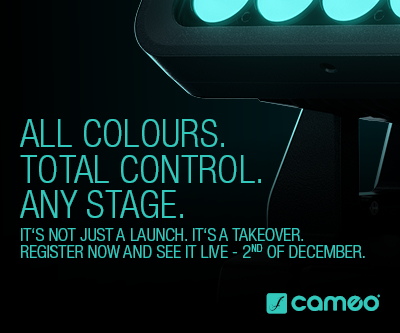

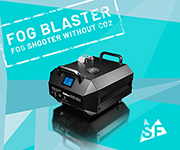
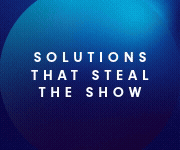

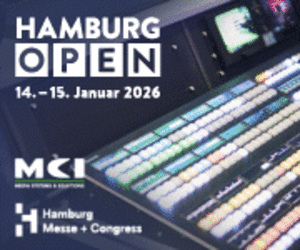
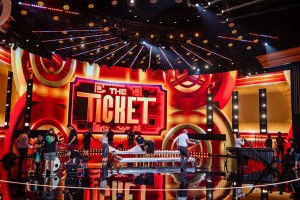
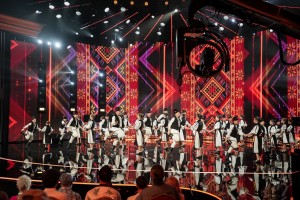
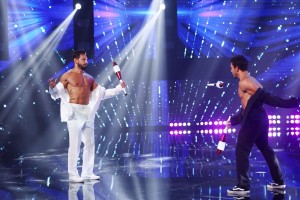

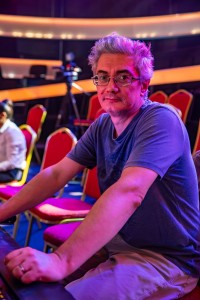
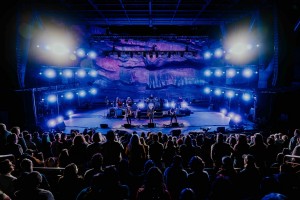
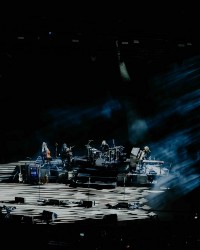
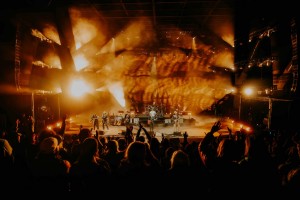
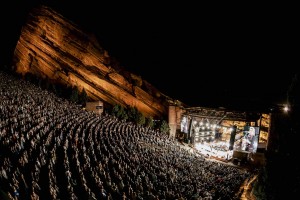
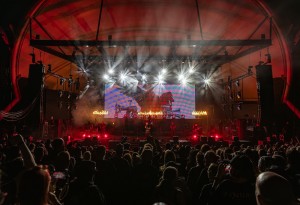
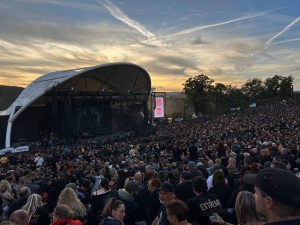
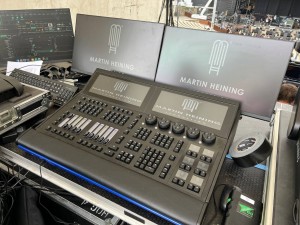
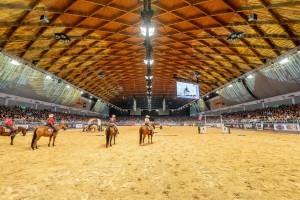
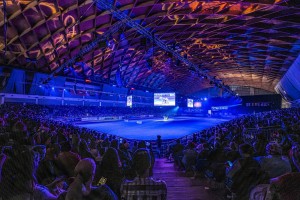
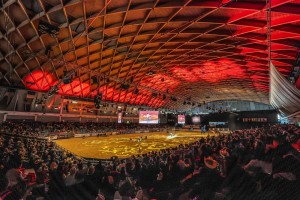
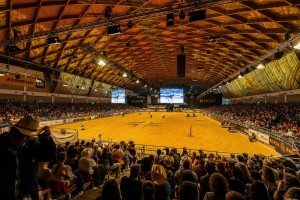
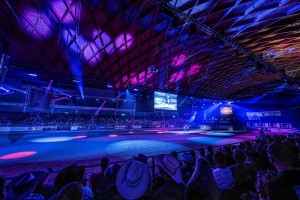
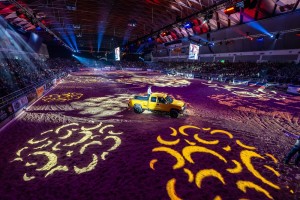
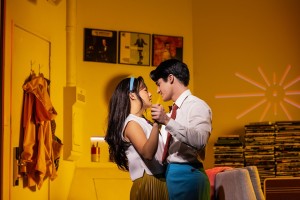
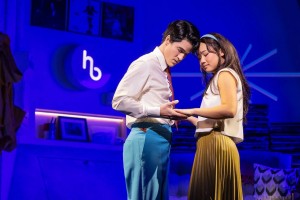
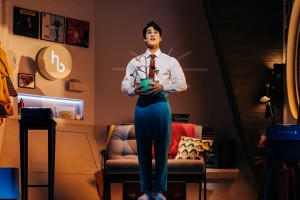
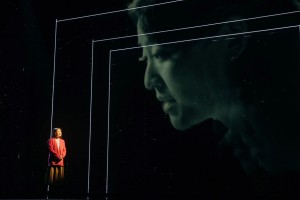
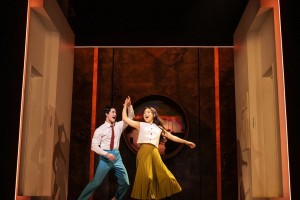
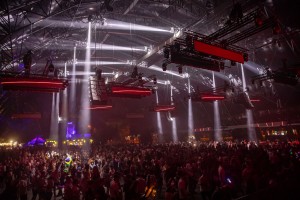
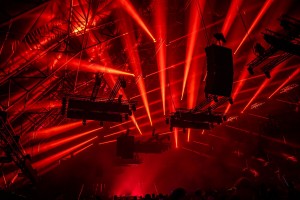
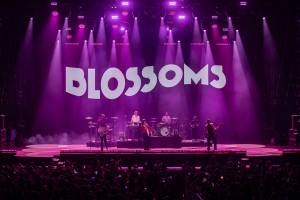
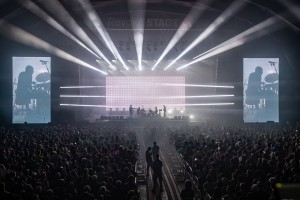
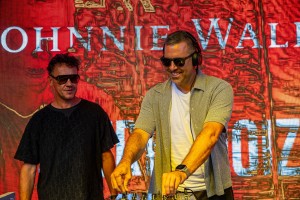
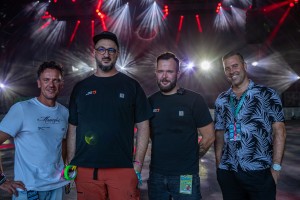
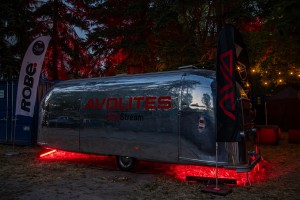
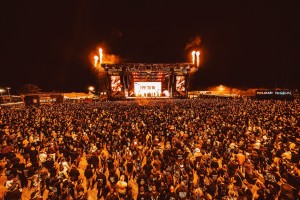
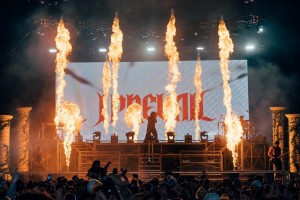
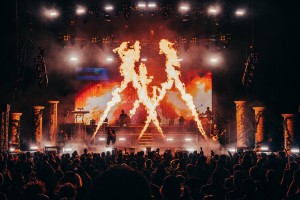
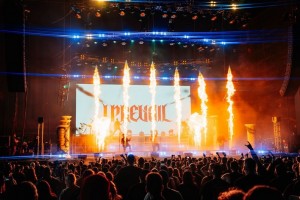
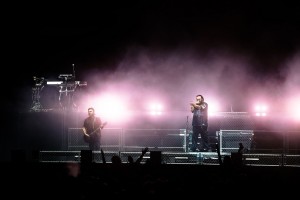
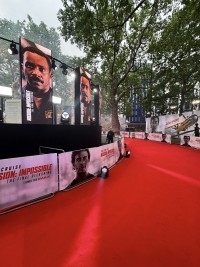
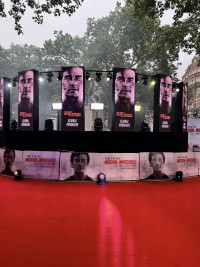
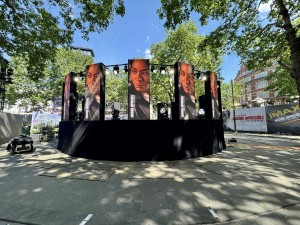
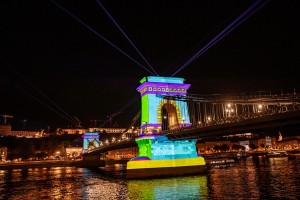
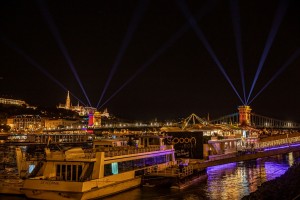
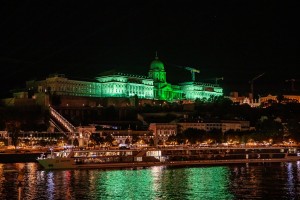
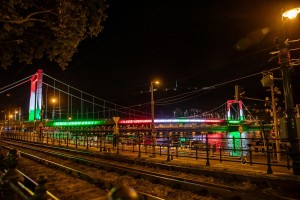
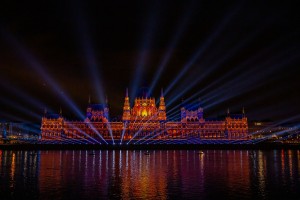
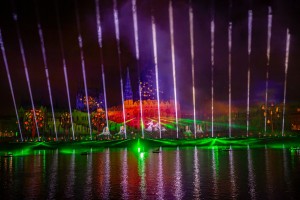
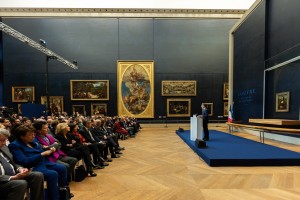
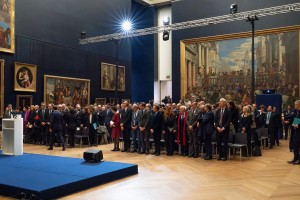
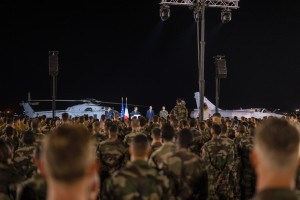
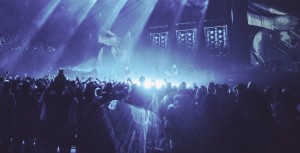
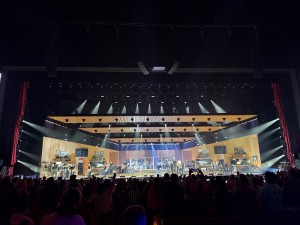
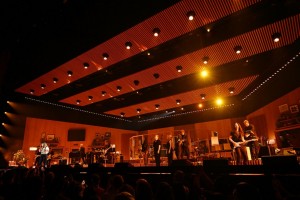
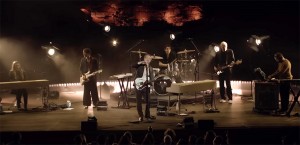
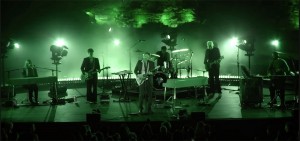
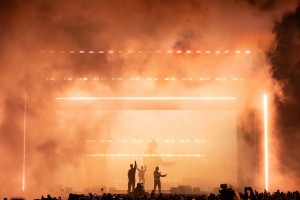
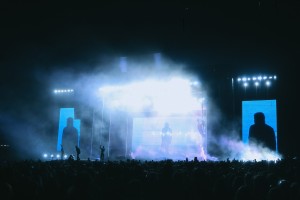
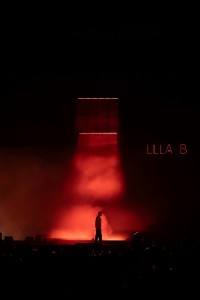
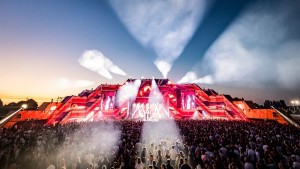
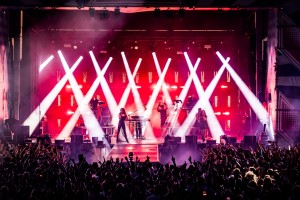
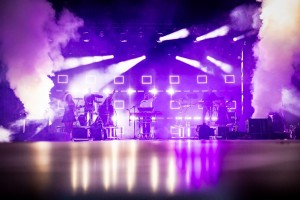
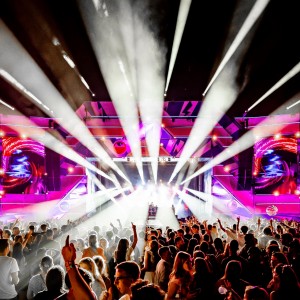
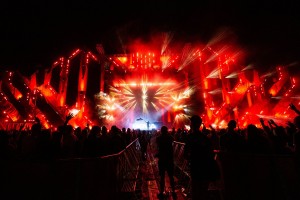
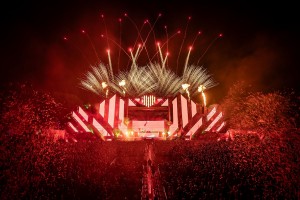
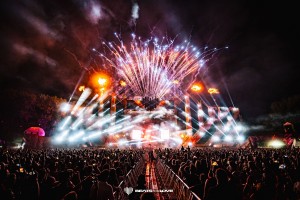
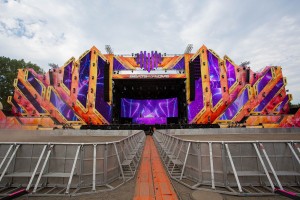
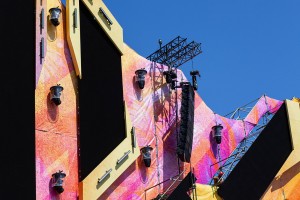
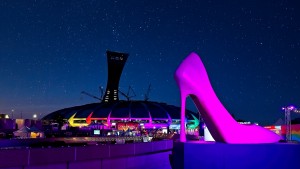
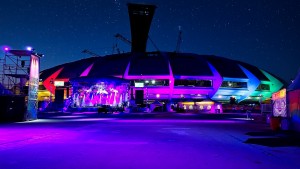
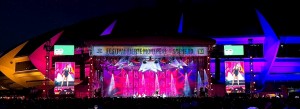
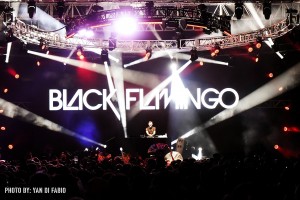
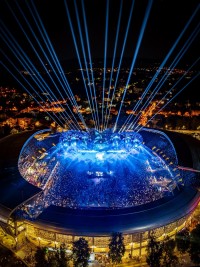
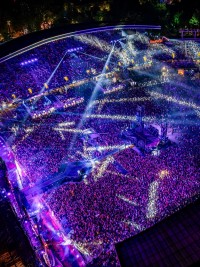
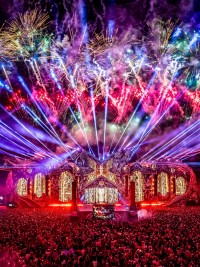
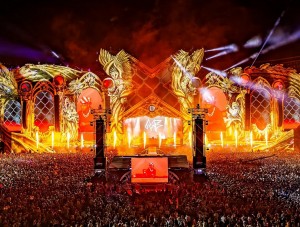
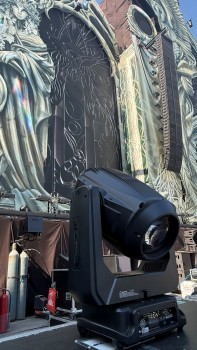
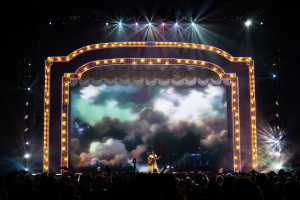
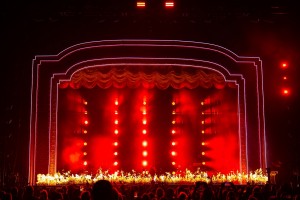
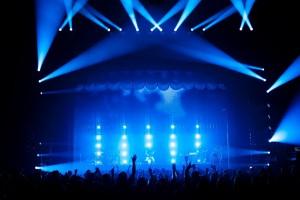
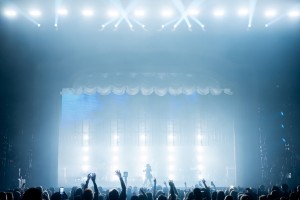
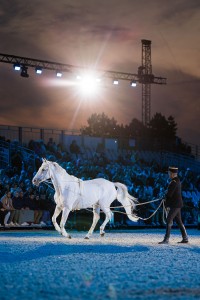
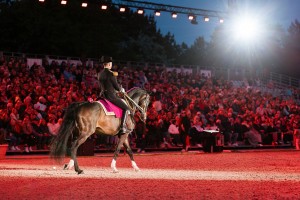
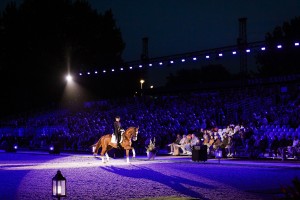
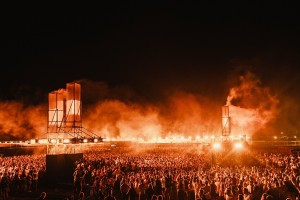
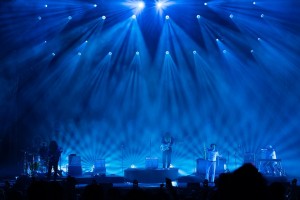
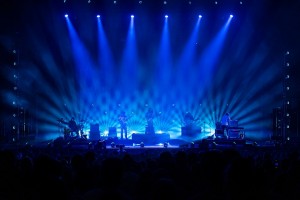
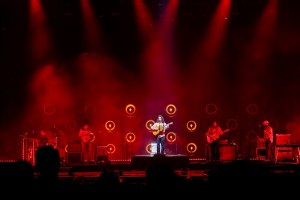
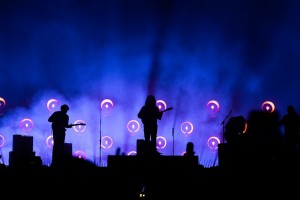
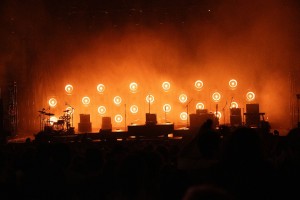
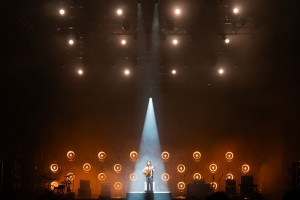
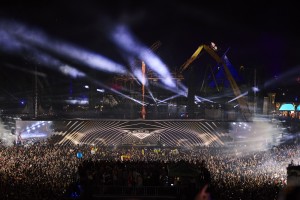
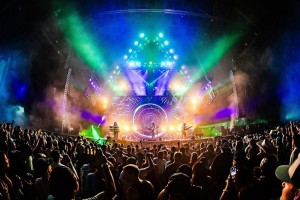
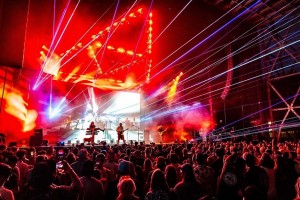
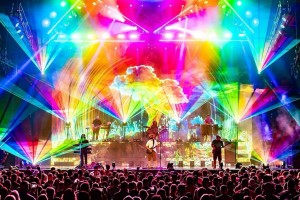
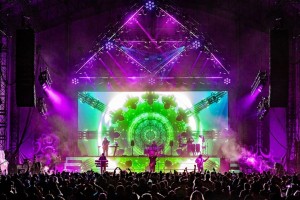
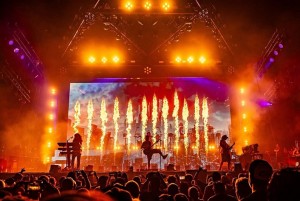
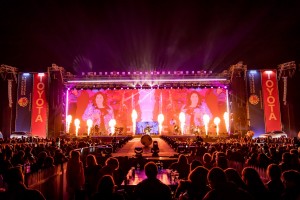
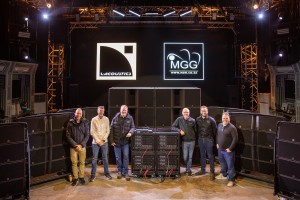
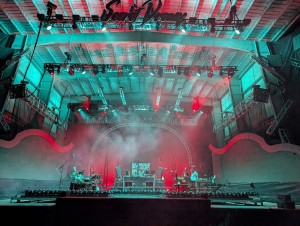

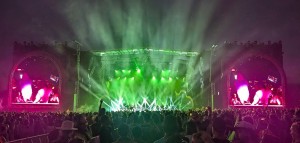
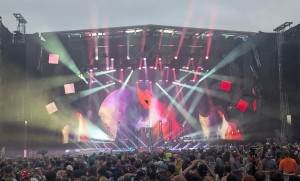
![Robe [Header]](/images/general/sponsors/Robe-Banner-2022.jpg)